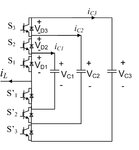kappa_am
Full Member level 6
Hi all,
Is there any way (gate driver) by which I can convert open-circuit fault caused by missing firing signal or driver fault to the short-circuit fault?
Thank you for your helps.
Is there any way (gate driver) by which I can convert open-circuit fault caused by missing firing signal or driver fault to the short-circuit fault?
Thank you for your helps.
